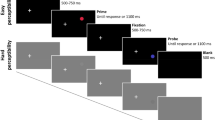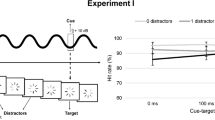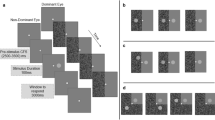Abstract
Previous dual-task studies showed that the selection and/or execution of a response interfere with concurrent visual encoding (action-induced blindness). Four experiments examined how the lateralization of stimuli and responses might affect action-induced blindness. Participants responded to tones (S1) by pressing keys with the left or right hand (R1), and simultaneously identified stimuli (S2) presented to the left or right visual field. Results revealed a complex pattern of cross-talk effects between response preparation and visual encoding. Firstly, preparing a response generally impaired concurrent visual encoding. Secondly, action-induced blindness was equally present for ipsilaterally and contralaterally presented stimuli. Thirdly, response preparation facilitated processing of visual stimuli at ipsilateral locations, probably a case of action-centered attention. Finally, the facilitatory effect of R1–S2 correspondence on visual encoding was complemented by a S2–R1 correspondence effect on response execution. Thus, acting while seeing can have both beneficial and detrimental effects on identification performance at the same time.





Similar content being viewed by others
References
Brainard DH (1997) The psychophysics toolbox. Spat Vis 10:433–436
Craft JL, Simon JR (1970) Processing symbolic information from a visual display: interference from an irrelevant directional cue. J Exp Psychol 83:415–420
Danielmeier C, Zysset S, Müsseler J, von Cramon DY (2004) Where action impairs visual encoding. Cogn Brain Res (in press)
De Jong R, Sweet, JB (1994) Preparatory strategies in overlapping-task performance. Percept Psychophys 55:142–151
Hellige JB (1996) Hemispheric asymmetry for visual information processing. Acta Neurobiol Exp 56:485–497
Hellige JB (2000) Hemispheric asymmetry: what’s right and what’s left. Harvard University Press, Cambridge MA
Jolicoeur P (1999) Dual-task interference and visual encoding. J Exp Psychol Hum Percept Perform 25:596–616
Lien MC, Proctor RW (2000) Multiple spatial correspondence effects on dual-task performance. J Exp Psychol Hum Percept Perform 26:1260–1280
Lien MC, Proctor RW (2002) Stimulus-response compatibility and psychological refractory period effects: implications for response selection. Psychon Bull Rev 9:212–238
Müsseler J, Wühr P (2002) Response-evoked interference in visual encoding. In: Prinz W, Hommel B (eds.) Attention and performance. XIX. Common mechanisms in perception and action. Oxford University Press, Oxford, pp 520–537
Müsseler J, Koch I, Wühr P (2004) Testing the boundary conditions for processing irrelevant location information: the cross-task Simon effect. Eur J Cogn Psychol (in press)
Pashler H (1998) Attention. Psychology Press, Hove UK
Pelli DG (1997) The VideoToolbox software for visual psychophysics: transforming numbers into movies. Spat Vis 10:437–442
Schubert T, Szameitat AJ (2003) Functional neuroanatomy of interference in overlapping dual tasks: an fMRI study. Cogn Brain Res 17:733–746
Sergent J, Hellige JB (1986) Role of input factors in visual-field asymmetries. Brain Cogn 5:174–199
Simon JR, Hinrichs JV, Craft JL (1970) Auditory S-R compatibility: reaction times as a function of ear-hand correspondence and ear-response-location correspondence. J Exp Psychol 86:97–102
Springer SP, Deutsch G (1998) Left brain, right brain. WH Freeman, New York
Szameitat AJ, Schubert T, Müller K, von Cramon DY (2002) Localization of executive functions in dual-task performance with fMRI. J Cogn Neurosci 14:1184–1199
Telford CW (1931) The refractory phase of voluntary and associative responses. J Exp Psychol 14:1-37
Tipper SP, Lortie C, Baylis GC (1992) Selective reaching: evidence for action-centered attention. J Exp Psychol Hum Percept Perform 18:891–905
Tomonaga M (2002) Action-based distractor effects on the manual response times of chimpanzees during discrimination tasks. Cogn Brain Res 13:235–240
Tootell RB, Mendola JD, Hadjikhani NK, Ledden PJ, Liu AK, Reppas JB et al. (1997) Functional analysis of V3A and related areas in human visual cortex. J Neurosci 17:7060–7078
van Selst M, Ruthruff E, Johnston JC (1999) Can practice eliminate the psychological refractory period effect? J Exp Psychol Hum Percept Perform 25:1268–1283
Wallace RJ (1971) S-R compatibility and the idea of a response code. J Exp Psychol 88:354–360
Wascher E, Schatz U, Kuder T, Verleger R (2001) Validity and boundary conditions of automatic response activation in the Simon task. J Exp Psychol Hum Percept Perform 27:731–751
Wühr P, Müsseler J (2002) Blindness to response-compatible stimuli in the psychological refractory period paradigm. Vis Cogn 9:421–457
Acknowledgements
The experiments were conducted while the first author was at the Max Planck Institute of Human Cognitive and Brain Sciences, Munich, Germany. We wish to thank two anonymous reviewers for their helpful comments and suggestions on a previous version of the paper and Silvia Bauer, Diana Berari, Veronika Gärtner, and Anja Kriegs for carrying out the experiments.
Author information
Authors and Affiliations
Corresponding author
Rights and permissions
About this article
Cite this article
Müsseler, J., Wühr, P., Danielmeier, C. et al. Action-induced blindness with lateralized stimuli and responses. Exp Brain Res 160, 214–222 (2005). https://doi.org/10.1007/s00221-004-2009-8
Received:
Accepted:
Published:
Issue Date:
DOI: https://doi.org/10.1007/s00221-004-2009-8




